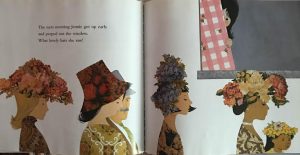Title: Grandpa’s Soup

Author: Eiko Kadono
Illustrator/Photographer: Satomi Ichikawa
Publisher and Year: Kaisei-Sha Publishing Co. and 1997
Number of pages: 31 pgs
Tags: Olivia Simkins, Fantasy, Fiction, 2-3, Culture, Picture Book, Fable
Genre: Fable
Analysis:
This book is about an old man whose wife passes away. He wakes up one day and decides to make the soup his wife used to make for him. As he makes the soup he realizes that he forgets a step and day by day and makes the soup over and over again until it is just right. Along the way he shares his soup with 3 mice, a cat, a dog and 9 children.
This story could function as a window because this book was originally published in Japanese and later was translated to English. With that being said, the audience can look into a different culture. The audience can see that in this man’s culture, his wife used to make him this special soup. In having him recreate this soup, the soup brings back memories of his wife and it shows how important it is to the old man to get the soup just right. It could also serve as a mirror from some readers. Some may read this story and relate their own lives to the old man’s. The text may remind them of a special dish one of their family members or friends make for them. This text does a good job of including different races and cultures throughout the book. Even though the words don’t ever really specify a certain culture the illustrations do.
The text in this book always appears to be on the opposite side of the picture until the second to last image when the children are sharing the soup with the cat, dog, mice and the man. This invites the audience to be a part of the story, as if the audience were sharing the soup along with the characters in the story. Also, in the very beginning of the story, the colors are very symbolic of the emotions conveyed in the story. The colors started out dark to show that the grandpa is very lonely and sad. As the story goes on the color get brighter and brighter to show his mood improving as he makes the soup better and better. This story could evoke the belief that the grandpa must share his soup with everyone else, leaving him to have a little portion of what he has made. Some may view this as a socialist view. Socialism is where the wealth or good is distributed between the community and every gets a “fair” share of anything and everything.






